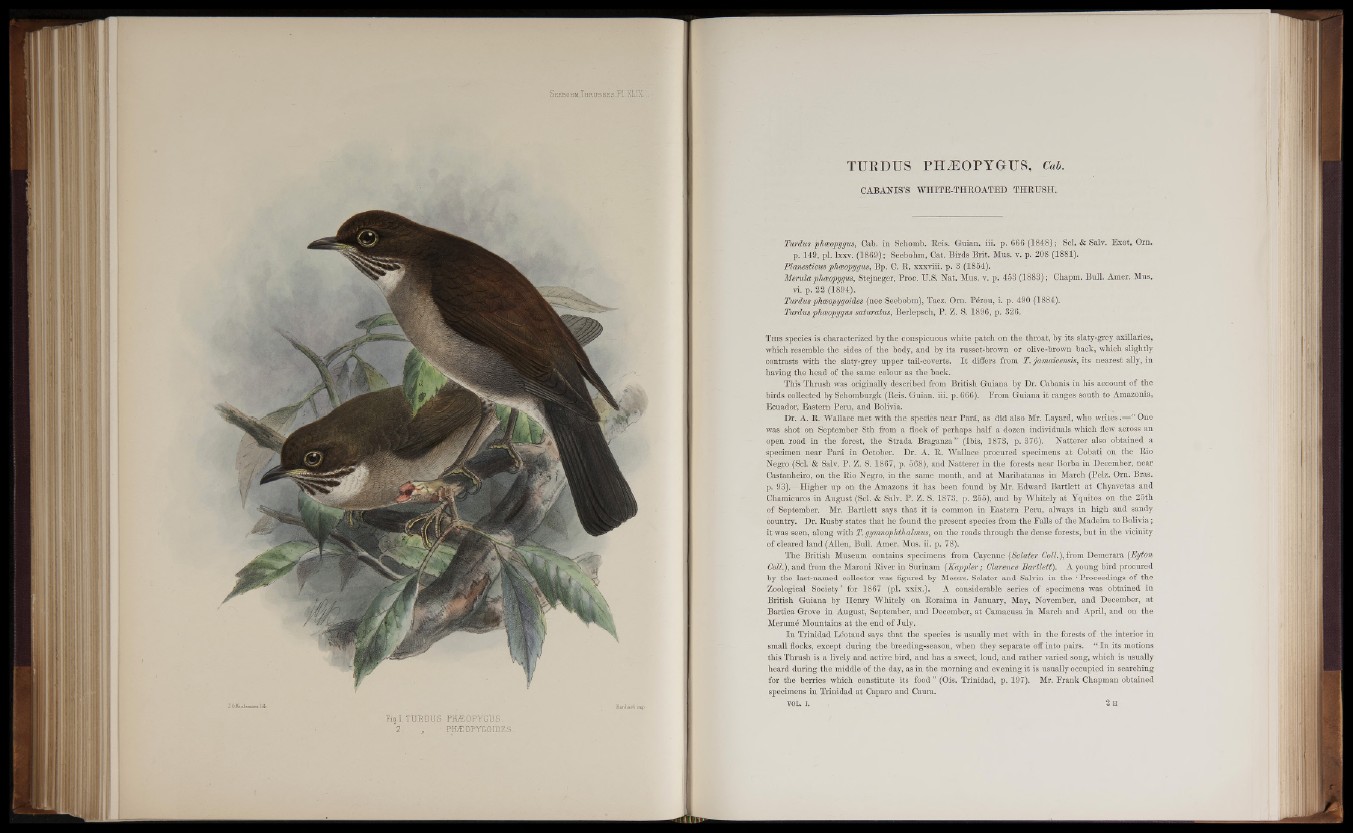
Fig I. TURDUS PREOPYGUS.
2 . 1 PREOPYGOIDES.
TURDUS PHiEOPYGrUS, Cab.
CABANIS’S WHITB-THE.OATED THRUSH.
Turdus phceopygus, Cab. in Schomb. Reis. Guian. iii. p. 666 (1848); Scl. & Salv. Exot, Om.
p. 149, pi. lxxv. (1869); Seebohm, Cat. Birds Brit. Mus. v. p. 208 (1881).
Planesticus phceopygus, Bp. C. R. xxxviii. p. 3 (1854).
Merula phceopygus, Stejneger, Proc. U.S. Nat. Mns. v. p. 453 (1883); Chapm. Bull. Amer. Mus.
vi. p. 22 (1894).
Turdus phceopygoides (nec Seebobm), Tacz. Orn. Perou, i. p. 490 (1884).
Turdus phceopygus saturatus, Berlepsch, P. Z. S. 1896, p. 326.
This species is characterized by the conspicuous white patch on the throat, by its slaty-grey axillaries,
which resemble the sides of the body, and by its russet-brown or olive-brown back, which slightly
contrasts with the slaty-grey’ upper tail-coverts. It differs from T. jamaicensis, its nearest ally, in
having the head of the same Colour as the back.
This Thrush was originally described from British Guiana by Dr. Cabanis in his account of the
birds collected bySchomburgk (Reis. Guian. iii. p. 666). From Guiana it ranges south to Amazonia,
Ecuador, Eastern Peru, and Bolivia.
Dr. A. R. Wallace met with the species near Para, as did also Mr. Layard, who w r i t e s “ One
was shot on September 8th from a flock of perhaps half a dozen individuals which flew across an
open road in the forest, the Strada Braganza” (Ibis, 1873, p. 376). Natterer also obtained a
specimen near Para in October. Dr. A. R. Wallace procured specimens at Cobati on the Rio
Negro (Scl. & Salv. P. Z. S. 1867, p. 568), and Natterer in the forests near Borba in December, near
Castanheiro, on the Rio Negro, in the same month, and at Maribatanas in March (Pelz. Orn. Bras,
p. 93). Higher up on the Amazons it has been found by Mr. Edward Bartlett at Chyavetas and
Chamicuros in August (Scl. & Salv. P. Z. S. 1873, p. 255), and by Whitely at Yquitos on the 25th
of September. Mr. Bartlett says that it is common in Eastern Peru, always in high and sandy
country. Dr. Rusby states that he found the present species from the Falls of the Madeira to Bolivia;
it was seen, along with T. gymnophtkalmus, on the roads through the dense forests, but in the vicinity
of cleared land (Allen, Bull. Amer. Mus. ii. p. 78).
The British Museum contains specimens from Cayenne (Sclater Coll.), from Demerara (Eyton
Coll.), and from the Maroni River in Surinam {Kappler; Clarence Bartlett). A young bird procured
by the last-named collector was figured by Messrs. Sclater and Salvin in the ‘ Proceedings of the
Zoological Society’ for 1867 (pi. xxix.). A considerable series of specimens was obtained in
British Guiana by Ilenry Whitely on Roraima in January, May, November, and December, at
Bartica Grove in August, September, and December, at Camacusa in March and April, and on the
Merume Mountains at the end of July.
In Trinidad Leotaud says that the species is usually met with in the forests of the interior in
small flocks, except during the breeding-season, when they separate off into pairs. “ In its motions
this Thrush is a lively and active bird, and has a sweet, loud, and rather varied song, which is usually
heard during the middle of the day, as in the morning and evening it is usually occupied in searching
for the berries which constitute its food ” (Ois. Trinidad, p. 197). Mr. Frank Chapman obtained
specimens in Trinidad at Caparo and Caura.
YOL. I . , 2 H